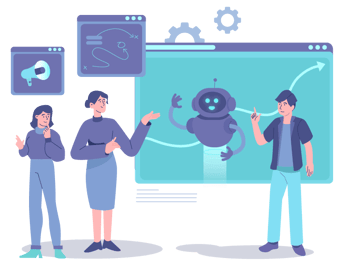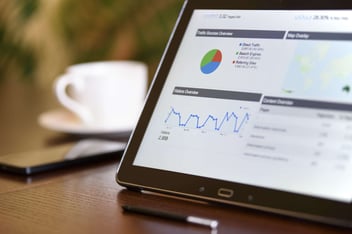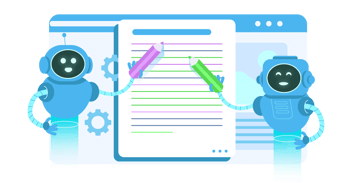Artificial Intelligence, a Glossary of Terms
Artificial intelligence (AI) has long been creeping into marketing technology. Chances are, you use multiple marketing tools that rely on at least some AI, even if you don't know it. As these technologies become more ubiquitous, it's important to understand what they are and how they impact the industry's future. Here's a look at some key AI-related terms and how Artificial Intelligence changes marketing.
 Algorithm
Algorithm
Simply put, an algorithm is a set of mathematical instructions. Each algorithm acts as step-by-step instructions for a computer program. Although algorithms once had to be explicitly programmed, today, some algorithms are designed to let computers learn independently (see the definition of machine learning below). Algorithms already permeate our everyday life. For instance, they determine the content we see on Facebook, Netflix, Amazon, and Google. Experts estimate that an algorithm suggests 75% of what we watch on Netflix.
Marketers have already been putting algorithms to work in myriad ways because algorithms can pull together data from various sources to predict and influence consumer behavior. Applying algorithms will also bring new accountability to marketing and media initiatives, as marketers will be increasingly empowered to link their efforts to business objectives.
Automation
The International Society of Automation (ISA) defines automation as "the creation and application of technology to monitor and control the production and delivery of products and services.” The introduction of automation to marketing revolutionized the industry, freeing professionals to spend their time on meaningful, value-added activities instead of repetitive tasks.
But even conventional automation's "Set it and forget it" approach is still quite manual intensive. A human must set up the process to be automated, and changes to that process must also be defined, initiated, and executed by a human. The future of automation will be powered by artificial intelligence, eliminating the need for additional human oversight (see the definition of intelligent automation below).
Big Data
2001 Gartner defined Big Data as "data that contains greater variety arriving in increasing volumes and with ever-higher velocity." That "three V's" definition is still the most widely used and accepted. In the ensuing years, marketers have faced an ever-growing body of data from ever-more diverse sources; 90% of all the world's data has been created in the past two years, and that volume continues to increase at accelerating speeds.

Indeed, Big Data has forced marketers to rethink how to assimilate seemingly endless information meaningfully. In the coming years, marketing teams will likely collaborate more closely with IT teams to implement the technologies necessary to handle vast data quantities. They will also have to make choices about which data truly contributes to better insights.
Bots
Bots have gotten a bad rap. Unethical marketers use bots to inflate traffic to a website by imitating page views or clicking on ads. But bots have plenty of positive power for marketing professionals. A bot is simply a software application that runs automated tasks via the internet, and you probably encounter bots online every day. Chatbots have popped up on websites all over the internet and have proven to be an excellent way to engage customers. But you can also use bots to conduct research, track projects, and even sell products on their own.
Bots are getting more sophisticated thanks to AI. For example, implementing an AI chatbot capable of more and more natural-sounding conversation will give organizations the power to engage with more website visitors and collect even more information about those visitors before a human intervenes in the conversation.
Deep Learning
Deep learning is a machine learning technique that relies on a neural network to help a computer learn by example, just as a human would. Deep learning technology provides the underpinning for driverless cars and voice-controlled consumer devices. The "examples" required for deep learning are incredibly large labeled data sets, which the computer uses to learn relevant classifications.
The performance of deep learning devices can surpass that of humans. In the marketing world, deep learning will likely revolutionize our approach to SEO as machines will get better and better at predicting ranking algorithms.
Intelligent Automation (IA)
Intelligent automation (IA) is the result of combining automation with artificial intelligence, resulting in automated data gathering, analysis, and decision-making. For example, say that someone fills out the Contact form on your website and includes a brief note or comments.
Automation alone allows your marketing team to notify the right people when the form is submitted and to send an autoresponder right away. But couple that capability with AI, and now the software can actually “read” the note to decide how urgent it is and who should follow up. In some cases, thanks to natural language processing (defined below), the software might even be able to respond appropriately.
Thanks to IA, personalization won't just mean including your email recipients' first names in email subject lines or salutations. You'll be able to get much more granular. Imagine emailing each contact at his or her ideal time based on previous behaviors. Or think about automatically sending just the right offer based on a person's recent search history.
We tend to think of artificial intelligence (AI) as tangible technologies, like robots or even Watson. But most AI-powered technology exists in a much more abstract form, in the form of algorithms. And that technology is essential for marketers who wish to stay at the forefront of the industry.
Internet of Things (IoT)
The Internet of Things (IoT) refers to connecting everyday devices to the Internet. It has already significantly impacted the global supply chain because it allows machines and other devices to "talk” to each other. For marketers, IoT promises to provide much more context for customers' habits, needs, desires, product usage, and purchase intent.
This year, IoT devices surpassed 7 billion, according to IoT Analytics. This is a boon to marketers, who stand to gain incredible insight into their customers at every stage of the buyer's journey. But it also presents a significant challenge: all these connected devices already produce mountains and mountains of data. As the number of devices grows, so will the quantity of data. Savvy marketers will enlist AI-powered technology to sift through everything and draw meaningful conclusions.
Machine Learning
In the past, robots and computers could automate tasks that fit within a specific set of rules. The device would be programmed to operate within the rules--nothing more, nothing less. But machine learning is exactly what it sounds like - machines can learn from the data they analyze, making predictions and forecasts using many more data points than humans could on their own. For example, while humans can analyze data from one source, says the website, machine learning means that you can glean insights from patterns in website usage, social media, email, and social media, along with customers' responses to previous campaigns.
Machine learning has multiple promising applications for marketers. It's the ideal technology for sophisticated customer segmentation, allowing you to identify small groups of customers who share preferences and tend to have similar behavior patterns. Machine learning can also predict customer churn, which allows marketers to proactively reach high-risk customers and decrease the likelihood of their attrition.
Natural Language Processing
Machines were once only able to understand code. But that has changed thanks to Natural Language Processing (NLP), which refers to a machine's ability to understand human language through machine learning and AI. NLP has evolved in recent years, and in some cases, this technology can understand the emotion or connotation behind human language. NLP is often paired with Natural Language Generation (NLG), where the machine processes the human language and generates a human-language response—voice-recognition systems like Amazon's Alexa and Apple's Siri work this way.
Many marketers already rely on some form of NLP for sentiment analysis. But it's also promising for personalization. Most organizations engage a geographically--and therefore linguistically--diverse audience. Those language differences may be subtle (such as regional variations in American English), more obvious (such as differences between American English and the Queen's English), or even involve different languages altogether. NLP can help you personalize communications based on these differences to deliver messages more likely to engage each recipient.
Neural Network
A neural network is essentially designed to mimic the human brain. The network is comprised of a series of layers. Each layer includes many nodes, or individual processing units, connected to other nodes in that layer along with nodes in the layers above and below. The lowest layer of the network takes in data and relays it to the next one. While the purpose of a neural network is to simulate a brain, the network will not function precisely as a human mind would. They are best used for pattern recognition, forecasting, trend prediction, and even generalization.
Microsoft used BrainMaker, a neural network software system, to optimize its direct mailing campaigns. The software identified the most critical variables in the success of direct mail campaigns so that future campaigns could be optimized. According to a company spokesperson, using BrainMaker increased the response rate from about 4.9% to 8.2%, a considerable improvement. This use of neural networks for campaign optimization holds excellent promise for marketers.
Predictive Analytics
A branch of advanced analytics, predictive analytics, is used to forecast future events using data mining, statistical modeling, and machine learning techniques. To maximize the benefits of predictive analytics, you must start with an extensive set of historical data. Rigorous data collection in marketing is relatively new--think how the role of analytics has changed in the last decade alone--so now predictive analytics has only recently emerged as a widely applicable technology in the last few years.
Amazon and other online retailers use predictive analytics extensively to model likely customer behavior. It can also be used for predictive lead scoring so the marketing and sales team can tailor campaigns and offerings to leads and customers most likely to convert. Meanwhile, applying predictive analytics to data about your existing high-value customers can help you develop strategies to reach more new customers like them.
Have a question about how AI can jumpstart your marketing?
This content is also available in:
- Deutsch: KI verstehen: Wie künstliche Intelligenz das Marketing revolutioniert
- Español: Glosario de términos de inteligencia artificial
- Français: Intelligence artificielle, un glossaire
- Italiano: Intelligenza artificiale, un glossario dei termini
- Română: Inteligența artificială, un glosar de termeni
- 简体中文: 人工智能术语表








Leave a Comment